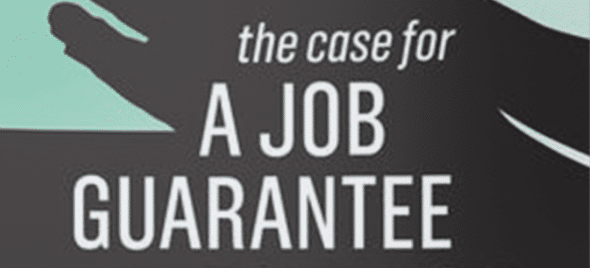Pavlina Tcherneva, a Professor of Economics at Bard College and a Research Scholar at the Levy Institute, has written a concisely, argued case for a federal job guarantee within the context of a Green New Deal. Citing its origins in FDR’s 1944 Economic Bill of Rights and the U.N.’s Universal Declaration of Rights, and the, at least nominal, commitment to the idea of full employment that prevailed through every administration until it was quashed with the election of Ronald Reagan, Tcherneva points out that it is a moral imperative, more needed than ever before. Although this book was written before A.I.’s threat to jobs became visible, Tcherneva’s call to action could not be more prescient.

The Case for a Job Guarantee by Pavlina R. Tcherneva, Polity Press (2020)
Tchernerva lays out the devastating price that both the unemployed and society in general pay for unemployment. Comparing unemployment to a deadly epidemic, she cites studies that link increased disease and mortality to unemployment as well as permanent lifetime earnings losses and reduced social capital and participation that make it harder to become re-employed. Like an epidemic, unemployment also has a contagion effect on the families of the unemployed in the form of malnutrition, growth stunting, mental health problems, poor educational outcomes for children and reduced social mobility for spouses and children. It contributes to urban blight, is a factor in violent and property crime, and is correlated with right wing extremism, human trafficking, forced and child labor, exploitation and slavery. There are also broader macroeconomic effects, such as increases in inequality and social exclusion that in turn exacerbate interracial and interethnic tensions. It negatively affects technological change, innovation and output, depresses economic growth and contributes to financial crises.
Why are such harmful effects tolerated? Tchernerva lays the blame on the policy goal known as the Non-Accelerating Inflation Rate of Unemployment, commonly known as the NAIRU. The NAIRU replaced full employment as the policy goal advocated by mainstream economists and pursued by the Federal Reserve Bank (the “Fed”). Their support for NAIRU is based on the argument that there is a “natural” rate of unemployment that must be maintained in order to tame inflationary pressures. In contrast, Tchernerva argues that there is nothing “natural” about unemployment. The “natural rate” argument is a myth that is not based on any solid economic evidence of causal relationship. Even Federal Reserve chairman, Jerome Powell, she points out, admitted under oath that the unemployment-inflation relationship had collapsed. She also debunks the widely held belief among politicians and the general public that people are unemployed due to some personal shortcoming: lack of required skills, inadequate education, or poor incentives and decision making. In reality, there are always more job seekers than jobs available, even at the peak of the business cycle.
Establishing a federal job guarantee, Tchernerva argues, would amount to establishing a new social contract and macroeconomic model. The job guarantee would provide the counter-cyclical economic stabilization that unemployment now serves. It would provide a minimum labor standard for all jobs and a wage floor that could help to raise wages in other parts of the economy. As a permanent feature of the safety-net, it would act as a critical preventive measure mitigating the kind of social ills produced by unemployment that are described above. And finally, as a cornerstone of a revived Economic Bill of Rights, it would be a vehicle for solving social and economic problems. Tcherneva frames this new social contract as a “Cares Act,” providing jobs that care for the environment, for the community, and for people and describing the many kinds of jobs such a program could provide.
A question that commonly arises is how such a program would be paid for. Tchernerva argues that such a question is based on a false assumption that the government can run out of funding. Tchernerva follows the tenets of the Modern Monetary Theory movement which holds that governments have the sovereign authority to issue unlimited amounts of their own currency. She points out that we regularly witness the government “finding the money” when it finances bank bailouts, billionaire tax cuts or endless wars. In other words, the fear of deficit spending and the push for balanced budgets is a political tool used by those who are opposed to certain policies that government funding might pay for.
One doesn’t necessarily have to subscribe to the Modern Monetary Theory, however, to imagine how such a program could be funded. NJFAN’s job guarantee proposal [Insert link] is based on the contention that unemployment costs governments more than a job guarantee would cost to end the problem. The NJFAN proposal would set up a Full Employment Trust Fund with additional tax revenues generated by the job guarantee, monies that otherwise would have been used for Unemployment Insurance Benefits and means-tested benefits that Program employees would have been entitled to receive but for their Program employment during the immediately preceding fiscal year, and other savings traceable to the beneficial social and medical effect of the job guarantee noted by Tcherneva. The NJFAN job guarantee proposal also includes two alternative sources of funding that could be used in case the reallocation of revenues and savings described above is incomplete or inadequate to fund the program and a third source of funding that could be tapped if the Trust Fund ran out of money during an exceptionally serious recession or other economic crisis.
It can also be funded from new taxes on securities transactions. If there are still insufficient funds in the Trust Fund, the Federal Reserve could be empowered to lend additional amounts to make the program solvent with the loans to be repaid over ten years.
To estimate how much a federal job guarantee program would cost, the Levy Institute simulated an ambitious program with both lower and higher estimates of spending. With conservative assumptions about the potential savings (taking into account only the savings to Medicaid and the Earned Income Tax Credit), the lower budgetary impact came out to .98 percent of GDP, while the upper budget came out to 1.33 percent of GDP. Compare this to the military’s share of GDP in 2023 at 3.1 percent of GDP. This, Tchernerva asserts, would result in boosting the GDP by nearly half a trillion dollars and increasing private sector employment by 3 to 4 million jobs without generating any inflationary effect of significance.
In her fifth chapter, Tcherneva outlines the design and implementation of a jobs program based on the concepts of prevention and preparedness. There are seven design features:
- The program is voluntary and inclusive, by which she means that it is open to anyone of legal working age who wants to work, “irrespective of labor market status, race, sex, color, or creed.” What she omits is whether the program would be open to disabled and formerly incarcerated persons, but later she notes that the program would also be “sensitive to the specific needs of veterans, at-risk youths, former inmates, and people with disabilities.”
- The program is permanent and targeted to serve as an automatic stabilizer.
- The basic wage/benefit package is fixed. Although Tcherneva suggests a basic wage of $15/hour, she admits this might not be enough and proposes a statutory review every few years to adjust the wage scale as needed. Benefits would include Social Security, health insurance, professional childcare, and paid leave.
- The program is federally funded but locally administered.
- Existing unemployment offices would serve as community job banks, soliciting projects from states, cities, non-religious and non-political non-profits, social enterprises, and cooperatives.
- The work would focus on public service employment, particularly care jobs.
- The program provides training, education, credentialing, and apprenticeship opportunities.
There are, she says, several ways to fund the program, and she gives examples of two. One would be to fund it out of the general budget as we do with Medicare Part D. The other would be to combine a base with supplemental appropriations as we do in emergency and disaster relief.
While all proponents of the Job Guarantee agree on its human rights framework and the provision of jobs with dignity and a minimum standard, they differ primarily in the level and structure of the Job Guarantee wage and the program’s administration and management. Tcherneva argues that those plans that favor a tiered wage structure would cause too much political wrangling, as they did during the New Deal and that such a plan would compete with skilled workers, thus depressing its price stabilization effects. In contrast, her proposal would pay all or almost all program participants the same “basic wage.” Rather than being indexed to inflation, it would incorporate legislation for regular reviews and mandatory increases in lockstep with increases in productivity to ensure it maintains a decent basic standard of living.
The job guarantee proposal of the National Jobs for All Network (NJFAN) would require that program participants to be paid the same wages and benefits that local public sector workers are paid for doing the same or comparable work in the community where they are employed. Supplemental benefits would be mandated for workers whose program wages are insufficient to support a decent standard of living. Tcherneva believes we can learn much from direct jobs programs that currently are or have been implemented in other countries, and she provides a brief review of such programs in India, Argentina, South Africa, and Sweden.
In the last part of the book, Tcherneva provides answers to frequently posed questions and objections, such as the fear that it would be: a “big government” takeover; be impossible to manage; that it would reduce productivity; create make-work projects; be dangerously disruptive; that technology would make all jobs obsolete anyway; that it would be impossible to add and shed workers on short notice; and that it would be politically impossible. Her answers to these concerns are compelling.
In sum, Tcherneva’s book provides an excellent introduction to the job guarantee idea. At the same time, it shows that differences of opinion exist among job guarantee advocates concerning the best design for certain features of a job guarantee program. Perhaps the difference between the funding strategy and wage policy of Tcherneva’s job guarantee proposal and the one proposed by the NJFAN could be discussed in a future issue of this Newsletter. A third topic that could be included in such a discussion is the administration of job guarantee projects. Both Tcherneva’s proposal and the NJFAN proposal would include non-profit organizations as potential project sponsors while a proposal advanced by Mark Paul, William Darity, and Darrick Hamilton would limit sponsorship to government agencies. Perhaps Tcherneva’s book can provide the impetus for useful discussions of all three of these differences in approach to the design of a job guarantee.
Sheila D. Collins is a professor emeritus of political science at William Paterson University and a public intellectual who has authored seven books and numerous book chapters, articles and encyclopedia entries on American politics and public policy, social movements, and religion. Among her most recent books are: Ubuntu: George M. Houser and the Struggle for Peace and Freedom on Two Continents, Ohio University Press, 2020; and When Government Helped: Learning from the Successes and Failures of the New Deal, Oxford University Press (co-authored and edited with Gertrude Goldberg).

